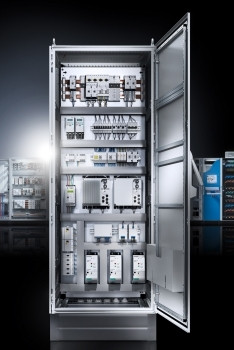
Electrical components in control enclosures generate heat. This heat needs to be efficiently dissipated from the enclosures so as to protect them against excessive temperatures. An active climate control solution such as a cooling unit is not always needed, though. Depending on the heat loss and the size of the enclosure, passive heat dissipation may be adequate.
Electrical and electronic components installed in an enclosure are usually designed for a maximum operating temperature of 50^0C. The period for which electrical components can be used depends to a large extent on the temperature. A 10^0C lower temperature doubles their service life. An internal enclosure temperature of 35^0C is normally selected as the ideal compromise between a component's service life and the degree of enclosure climate control.
Benefits of passive heat dissipation
In principle, there are two ways of dissipating the (lost) heat from an enclosure - a medium (air or cooling water) that conveys the heat away from the enclosure or convective heat transfer via the enclosure surface. The first option - active cooling - requires additional equipment such as fan-and-filter units, cooling units or air/water heat exchangers. In the case of passive heat dissipation, heat is conveyed exclusively via the enclosure panels. The benefits of this are clear. The initial outlay is lower because no additional equipment is required, and users also subsequently save on both energy and maintenance costs. The absence of additional openings in the enclosure panels means the system is better protected against dust and moisture. What's more, a completely closed enclosure facilitates EMC protection and eliminates the condensation that active cooling can cause to form. Uniform heat loss also means a constant enclosure temperature, so components are subject to lower stresses associated with changes in temperature than in the case of active climate control.

Larger surface areas improve heat dissipation
Passive dissipation does have its limits, however, because of the physical principle involved. The lower the ambient temperature, the more effectively this method works. The enclosure material's heat transfer coefficient and the effective enclosure surface area are also key dissipation factors. DIN EN 0660-600-1 supplement 2 / IEC TR 60890890 indicates how the latter is calculated. Based on a defined enclosure size, the effective enclosure surface area is at a maximum with a free-standing enclosure. Enclosure baying, wall mounting or covering the roof surfaces reduces this area. If the enclosure components' heat loss and the ambient temperature are defined, it is easy to calculate the average temperature inside the enclosure.
If the temperature calculated exceeds the required internal enclosure temperature, active cooling is not necessarily a must. Using a slightly larger enclosure, for instance, may mean passive dissipation is adequate after all. With small enclosures in particular, a slight increase in surface area can significantly reduce the maximum internal enclosure temperature. This should be taken into account when dimensioning a control enclosure with a low heat load.
Another option is to install components with particularly high heat losses - such as braking resistors - outside the enclosure. Skilful planning of controls and switchgear is therefore a highly effective means of cutting dissipation costs. The size of enclosures, their installation and the positioning of components with the highest heat losses play a key role in this respect.

The enclosure material also has an influence on climate control. Spray-finished sheet steel or stainless steel enclosures with a heat transfer coefficient of approx. k=5.5 W/m2xK traditionally predominate in mechanical engineering applications, but the coefficient changes according to the design, for example with double-walled or insulated enclosures for other sectors or outdoor applications.
Share